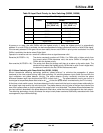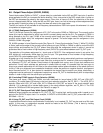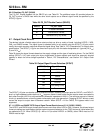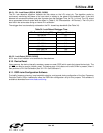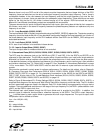
Si53xx-RM
70 Rev. 0.5
6.4. Digital Hold/VCO Freeze
All Any-Frequency Precision Clock devices feature a hold over or VCO freeze mode, whereby the DSPLL is locked
to a digital value.
6.4.1. Narrowband Digital Hold (Si5316, Si5323, Si5366)
If an LOS or FOS condition exists on the selected input clock, the device enters digital hold. In this mode, the
device provides a stable output frequency until the input clock returns and is validated. When the device enters
digital hold, the internal oscillator is initially held to its last frequency value. Next, the internal oscillator slowly
transitions to a historical average frequency value that was taken over a time window of 6,711 ms in size that
ended 26 ms before the device entered digital hold. This frequency value is taken from an internal memory location
that keeps a record of previous DSPLL frequency values. By using a historical average frequency, input clock
phase and frequency transients that may occur immediately preceding loss of clock or any event causing digital
hold do not affect the digital hold frequency. Also, noise related to input clock jitter or internal PLL jitter is
minimized.
If a highly stable reference, such as an oven-controlled crystal oscillator, is supplied at XA/XB, an extremely stable
digital hold can be achieved. If a crystal is supplied at the XA/XB port, the digital hold stability will be limited by the
stability of the crystal.
6.4.2. Recovery from Digital Hold (Si5316, Si5323, Si5366)
When the input clock signal returns, the device transitions from digital hold to the selected input clock. The device
performs hitless recovery from digital hold. The clock transition from digital hold to the returned input clock includes
“phase buildout” to absorb the phase difference between the digital hold clock phase and the input clock phase.
6.4.3. Wideband VCO Freeze (Si5322, Si5365)
If an LOS condition exists on the selected input clock, the device freezes the VCO. In this mode, the device
provides a stable output frequency until the input clock returns and is validated. When the device enters VCO
freeze, the internal oscillator is initially held to its last frequency value.
6.5. Frame Synchronization (Si5366)
FSYNC is used in applications that require a synchronizing pulse that has an exact number of periods of a high-
rate clock, Frame Synchronization is selected by setting CK_CONF = 1 and FRQTBL = L). In a typical frame
synchronization application, CKIN1 and CKIN2 are high-speed input clocks from primary and secondary clock
generation cards and CKIN3 and CKIN4 are their associated primary and secondary frame synchronization
signals. The device generates four output clocks and a frame sync output FS_OUT. CKIN3 and CKIN4 control the
phase of FS_OUT.
The frame sync inputs supplied to CKIN3 and CKIN4 must be 8 kHz. Since the frequency of FS_OUT is derived
from CKOUT2, CKOUT2 must be a standard SONET frequency (e.g. 19.44 MHz, 77.76 MHz). Table 16 lists the
input frequency/clock multiplication ratio combinations supporting an 8 kHz output on FS_OUT.










